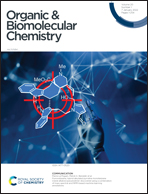Design of novel tripyridinophane-based Eu(iii) complexes as efficient luminescent labels for bioassay applications†
Abstract
In this work, the development of highly luminescent europium(III) complexes in water solution is reported, including their syntheses, analyses of their photophysical properties and applications in bioassays. Three Eu(III) complexes are derived from new ligands based on a tripyridinophane platform. There are four distinct sections in the structure of these ligands: an 18-membered polyaminocarboxylic macrocycle to bind efficiently lanthanide ions in aqueous solutions, three chromophoric subunits (4-(phenylethynyl)pyridine moieties) to effectively sensitize the emission of the metal, two peripheral moieties to solubilise the complex in aqueous media (sulfonate, sulfobetaine or glucose groups) and a free NH2 group available for grafting or bioconjugation. In our synthetic procedure, a pivotal macrocyclic platform is obtained with a high yield in the crucial macrocyclization step due to a metal template ion effect (74% yield). In Tris aqueous buffer (pH 7.4), the Eu(III) complexes show a maximum excitation wavelength at 320 nm, a suitable overall quantum yield (14%), a relatively long lifetime (0.80 ms) and a one-photon brightness in the range of 10 000 M−1 cm−1. Importantly, these photophysical properties are retained at dilute concentrations, even in the presence of a very large excess of potentially competing species, such as EDTA or Mg2+ ions. Furthermore, we report the bioconjugation of a Eu(III) complex labelled by an N-hydroxysuccinimide ester reactive group with an antibody (anti-glutathione-S-transferase) and the successful application of the corresponding antibody conjugate in the detection of GST-biotin in a fluoroimmunoassay. These new complexes provide a solution for high sensitivity in Homogeneous Time-Resolved Fluorescence (HTRF®) bioassays.



 Please wait while we load your content...
Please wait while we load your content...